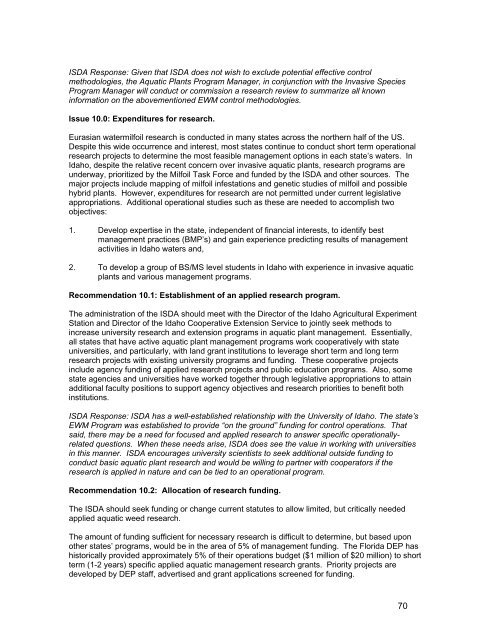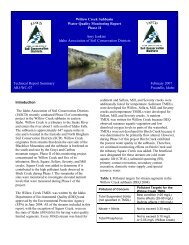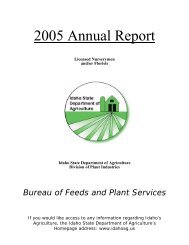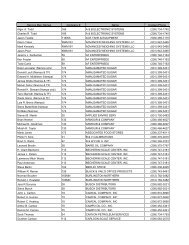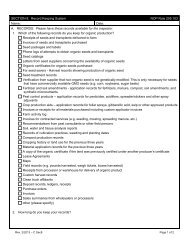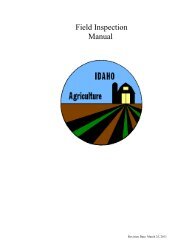2008 Statewide Strategic Plan for Eurasian Watermilfoil in Idaho
2008 Statewide Strategic Plan for Eurasian Watermilfoil in Idaho
2008 Statewide Strategic Plan for Eurasian Watermilfoil in Idaho
Create successful ePaper yourself
Turn your PDF publications into a flip-book with our unique Google optimized e-Paper software.
ISDA Response: Given that ISDA does not wish to exclude potential effective control<br />
methodologies, the Aquatic <strong>Plan</strong>ts Program Manager, <strong>in</strong> conjunction with the Invasive Species<br />
Program Manager will conduct or commission a research review to summarize all known<br />
<strong>in</strong><strong>for</strong>mation on the abovementioned EWM control methodologies.<br />
Issue 10.0: Expenditures <strong>for</strong> research.<br />
<strong>Eurasian</strong> watermilfoil research is conducted <strong>in</strong> many states across the northern half of the US.<br />
Despite this wide occurrence and <strong>in</strong>terest, most states cont<strong>in</strong>ue to conduct short term operational<br />
research projects to determ<strong>in</strong>e the most feasible management options <strong>in</strong> each state’s waters. In<br />
<strong>Idaho</strong>, despite the relative recent concern over <strong>in</strong>vasive aquatic plants, research programs are<br />
underway, prioritized by the Milfoil Task Force and funded by the ISDA and other sources. The<br />
major projects <strong>in</strong>clude mapp<strong>in</strong>g of milfoil <strong>in</strong>festations and genetic studies of milfoil and possible<br />
hybrid plants. However, expenditures <strong>for</strong> research are not permitted under current legislative<br />
appropriations. Additional operational studies such as these are needed to accomplish two<br />
objectives:<br />
1. Develop expertise <strong>in</strong> the state, <strong>in</strong>dependent of f<strong>in</strong>ancial <strong>in</strong>terests, to identify best<br />
management practices (BMP’s) and ga<strong>in</strong> experience predict<strong>in</strong>g results of management<br />
activities <strong>in</strong> <strong>Idaho</strong> waters and,<br />
2. To develop a group of BS/MS level students <strong>in</strong> <strong>Idaho</strong> with experience <strong>in</strong> <strong>in</strong>vasive aquatic<br />
plants and various management programs.<br />
Recommendation 10.1: Establishment of an applied research program.<br />
The adm<strong>in</strong>istration of the ISDA should meet with the Director of the <strong>Idaho</strong> Agricultural Experiment<br />
Station and Director of the <strong>Idaho</strong> Cooperative Extension Service to jo<strong>in</strong>tly seek methods to<br />
<strong>in</strong>crease university research and extension programs <strong>in</strong> aquatic plant management. Essentially,<br />
all states that have active aquatic plant management programs work cooperatively with state<br />
universities, and particularly, with land grant <strong>in</strong>stitutions to leverage short term and long term<br />
research projects with exist<strong>in</strong>g university programs and fund<strong>in</strong>g. These cooperative projects<br />
<strong>in</strong>clude agency fund<strong>in</strong>g of applied research projects and public education programs. Also, some<br />
state agencies and universities have worked together through legislative appropriations to atta<strong>in</strong><br />
additional faculty positions to support agency objectives and research priorities to benefit both<br />
<strong>in</strong>stitutions.<br />
ISDA Response: ISDA has a well-established relationship with the University of <strong>Idaho</strong>. The state’s<br />
EWM Program was established to provide “on the ground” fund<strong>in</strong>g <strong>for</strong> control operations. That<br />
said, there may be a need <strong>for</strong> focused and applied research to answer specific operationallyrelated<br />
questions. When these needs arise, ISDA does see the value <strong>in</strong> work<strong>in</strong>g with universities<br />
<strong>in</strong> this manner. ISDA encourages university scientists to seek additional outside fund<strong>in</strong>g to<br />
conduct basic aquatic plant research and would be will<strong>in</strong>g to partner with cooperators if the<br />
research is applied <strong>in</strong> nature and can be tied to an operational program.<br />
Recommendation 10.2: Allocation of research fund<strong>in</strong>g.<br />
The ISDA should seek fund<strong>in</strong>g or change current statutes to allow limited, but critically needed<br />
applied aquatic weed research.<br />
The amount of fund<strong>in</strong>g sufficient <strong>for</strong> necessary research is difficult to determ<strong>in</strong>e, but based upon<br />
other states’ programs, would be <strong>in</strong> the area of 5% of management fund<strong>in</strong>g. The Florida DEP has<br />
historically provided approximately 5% of their operations budget ($1 million of $20 million) to short<br />
term (1-2 years) specific applied aquatic management research grants. Priority projects are<br />
developed by DEP staff, advertised and grant applications screened <strong>for</strong> fund<strong>in</strong>g.<br />
70


